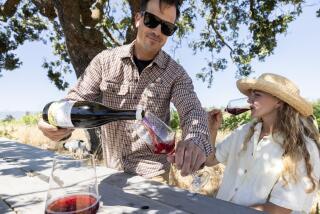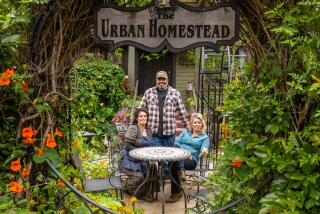Family vacation at Willow-Witt Ranch in Oregon
- Share via
Here are some unintended consequences of our family’s late-August vacation at the Willow-Witt Ranch in southern Oregon:
Our children, then 22 months and 4, prefer fresh goat’s milk to the store-bought stuff from a cow.
They also think it is appropriate to chase chickens and ducks, if they happen to be around.
And our 22-month-old son thinks “Gretchen” is the word for goat — maybe because he spent so much time with a goat by that name during the three days we stayed on the farm.
Americans’ surging interest in the origin of their food has led to a renaissance in farm stays in which vacationers, usually urban folk, pay to spend a few days on a working farm and even contribute a little labor.
In some cases, the experience can be expensive. Farm folks’ eyebrows shot up last summer when the New York Times reported that one of its writers had paid more than $300 a night to stay in a tent on a farm in upstate New York — although it sounded like a very nice tent.
In California, where the value of agritourism has jumped from $6.6 million in 2002 to $34 million in 2007, the Philo Apple Farm in Mendocino charges $250 a night, plus $625 a person for weekend cooking classes, a fee that Penny Leff, the agritourism coordinator for the University of California’s Small Farm program, pronounced “impressive.”
I almost hope they don’t hear about this in Oregon, where farmers have embraced the farm-stay concept and the rates are still relatively modest.
For our visit, we had about a half-dozen newly launched programs to choose from, including Pennington Farms, which began accepting guests about two years ago and specializes in berries, and the Leaping Lamb Farm, which has its own burbling creek. Scottie Jones, who owns Leaping Lamb, said she had advised about 25 other Oregon farmers on how to open their own overnight programs.
“This is actually how the farm is becoming sustainable,” Jones said, noting that most small family farms can’t make enough money from agriculture to get into the black. But Jones, like many farm-stay operators, added that she had come to view her business as a community service, “a way to introduce Americans back to that farm culture.”
We chose Willow-Witt Ranch, which sits in a meadow about 4,600 feet above Ashland in the southern Cascade Range, because we liked the idea of being able to pop into Ashland with its fudge shops, actors in Elizabethan dress and gourmet restaurants. Even better for a late-August visit, we liked that the temperature was 20 degrees cooler at the farm than in town.
We arrived in the evening and were delighted to discover that our $135-a-night fee got us a charming studio with a sleeping loft, a wood stove, a full kitchen and enough board games to occupy our family for months. The price also included tutorials in how to milk a goat, approach a horse and talk to a piglet. For an extra fee, we could purchase sausage produced from the farm’s pigs, fresh eggs and goat’s milk. I confess that I pinched some basil from the garden, as well as some blackberries growing wild around the place.
On our first morning, we discovered that our window looked out on a pasture of frolicking goats. We could also see chickens, ducks, horses, pigs, cats and dogs scattered around the farmyard. Towering above them was a dense forest of white fir, Ponderosa pine and Douglas fir.
We let the children go outside and sat down to watch as we drank strong coffee and goat’s milk and ate fresh sausage.
After we finally had had enough coffee, we went to help milk the goats.
Willow-Witt is owned by Suzanne Willow and Lanita Witt, who during the last two decades have tried to restore the wetlands, revitalize the forest and otherwise make the farm as environmentally sustainable as possible. This means they have installed solar panels and even a solar-powered shower. It also means they have hired several farmworkers and interns who bring a missionary zeal to their love of organic, sustainable farming.
As we wandered the farm, smiling workers stopped us to show our daughter the baby chickens that had just arrived by UPS that morning and to teach us how to milk a goat. We marveled at the labor involved: The farm’s seven milk goats are milked twice each day, which takes about an hour. Workers said they got a total of about 9 gallons a day. Even our 4-year-old seemed impressed. Then she and her brother guzzled about a half-gallon of the stuff, laughing as they wiped milk mustaches on each other’s faces.
In the afternoons, we had a host of alpine activities to choose from. One day we drove a short distance to a 11/2-mile trail leading to Grizzly Peak, which afforded a view of rolling forests. On another, we visited one of the many nearby lakes for swimming.
In the evenings, we returned to the farm and, as the sun set over the meadow, prepared simple dinners and then went to sleep. By our second morning, we found ourselves falling into the rhythm of farm life, waking as the sun began to rise over the trees.
We lay in bed, thinking about getting up to help with the chores. Then we smiled and went back to sleep. After all, we were on vacation.
More to Read
Sign up for The Wild
We’ll help you find the best places to hike, bike and run, as well as the perfect silent spots for meditation and yoga.
You may occasionally receive promotional content from the Los Angeles Times.






